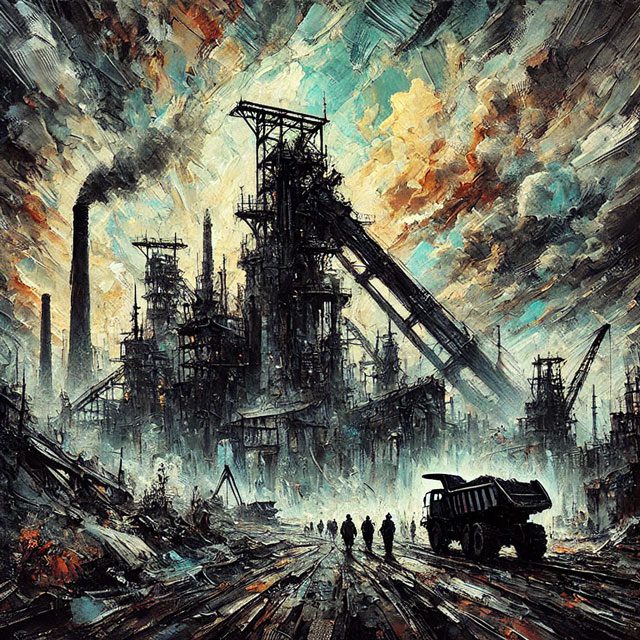
The coal industry is in decline. With environmental concerns and the shift to renewable energy, coal is losing its relevance. Jobs are disappearing, and communities that once thrived on coal mining are facing economic collapse. But there’s an unexpected force that could help: art. Yes, art. This article explores whether art can breathe new life into an industry that many believe is beyond saving. Could creativity and culture offer a future for coal towns? Let’s dive into the possibilities.
The Coal Industry: A Sector on Life Support
The coal industry is struggling. Decades of heavy reliance on coal as an energy source are catching up with it. Environmental regulations, health concerns, and the rise of alternative energy sources have hit coal hard. The result? A shrinking industry with dwindling job opportunities. Many coal towns are seeing their economies crumble as mines close and workers move away in search of new livelihoods.
Coal mining used to be the backbone of many communities. For generations, families worked in the mines, building lives around this labor-intensive industry. But now, the decline is undeniable. The number of people employed in coal mining has plummeted. In the United States alone, coal production has fallen by almost 50% since its peak in the late 2000s. This decline leaves a significant gap, not only in the energy market but also in the lives of those who depended on coal for their survival.
Governments and industry leaders have been scrambling to find solutions. Some propose technological advancements to make coal mining more sustainable. Others suggest policies to transition workers into other industries. Yet, despite these efforts, the future of coal remains uncertain. The industry is on life support, and traditional approaches might not be enough to save it.
But what if there was another way? A way to transform these coal-dependent communities without abandoning their heritage? This is where the idea of art comes into play. Art, with its power to inspire, unite, and rejuvenate, might just hold the key to a new beginning for the coal industry.
The Power of Art: More Than Just Aesthetic Appeal
Art isn’t just about beauty. It has the power to change the way people think and feel. Throughout history, art has played a crucial role in societal change. From political movements to urban revitalization, art has been at the forefront of transformation. Could this same power be harnessed to revitalize the coal industry? The potential is worth exploring.
Art can bring people together. In coal towns where the economy is failing, art can unite the community. Public art installations, murals, and sculptures can bring new life to forgotten places. These creative endeavors can become symbols of hope, reminding residents of their shared history and potential future. In towns where coal mining once reigned supreme, art can help residents reimagine their identity.
Art also has a psychological impact. It can boost morale and provide a sense of purpose. In areas hit hard by the decline of coal, this is crucial. Art projects can give people something to rally around, helping them cope with the economic downturn. By engaging in creative activities, individuals can find new meaning and direction in their lives.
Historically, art has been used to revitalize industries. Take, for example, the urban revitalization efforts in cities like Detroit. After the collapse of the automotive industry, art played a pivotal role in the city’s rebirth. Abandoned buildings were transformed into galleries, public spaces were adorned with murals, and the city became a hub for creativity. This transformation attracted tourists, investors, and new residents, sparking an economic revival. If art could help bring back a city like Detroit, could it do the same for coal towns?
The potential of art to create change is undeniable. It can transform spaces, uplift communities, and inspire action. For the coal industry, this could mean a new way forward, one that honors the past while embracing a creative future.
Where Art Meets Coal: Real-World Examples
Art and coal may seem like an odd pairing, but there are real-world examples where they intersect in meaningful ways. These examples show that art can indeed play a role in revitalizing coal communities, providing a glimmer of hope for those facing economic hardships.
One striking example is found in the town of Zollverein in Germany. Zollverein was once home to one of the largest coal mines in Europe. When the mine closed in 1986, the town faced an uncertain future. But instead of fading into obscurity, Zollverein embraced its industrial heritage in a new way. The former coal mine was transformed into a UNESCO World Heritage site, complete with museums, galleries, and art installations. Artists from around the world have contributed to the site, creating a vibrant cultural hub that attracts tourists and art lovers alike. This transformation has breathed new life into the community, creating jobs and boosting the local economy.
Another example can be found in the Appalachian region of the United States. Known for its coal mining heritage, this region has struggled with economic decline as the coal industry has waned. However, artists and local organizations have begun to use art as a tool for revitalization. The “Appalachian Artisan Center” in Kentucky is one such initiative. This center provides training and resources for local artists, helping them develop their skills and create marketable products. By turning to art, these communities are finding new ways to generate income and preserve their cultural heritage.
In the United Kingdom, the town of Easington offers yet another example. Easington was once a thriving coal mining community, but the closure of its mines in the 1990s led to economic collapse. To combat this, local artists and residents came together to create “The Easington Colliery Banner Project.” This project involved the creation of large, colorful banners that told the story of the town’s mining history. The banners were displayed in public spaces, sparking conversations about the community’s past and future. The project not only brought the town’s history to life but also provided a sense of pride and identity for its residents.
These case studies demonstrate the potential for art to revitalize coal communities. By embracing their industrial past and infusing it with creativity, these towns have found new ways to thrive. Art has provided them with a means to honor their heritage while also looking forward to a brighter future.
Can Art Really Save Coal? Exploring the Possibilities
The idea of art saving the coal industry may seem far-fetched, but there are real possibilities worth considering. Art could play a significant role in economic development, community engagement, and cultural preservation in coal-dependent regions.
Economically, art can attract tourism. In places where traditional industries are failing, tourism can provide a much-needed boost. Former coal towns can capitalize on their industrial heritage by creating cultural attractions that draw visitors. Museums, galleries, and public art installations can become major tourist destinations. As seen in Zollverein, this approach can create jobs, generate income, and revitalize local economies.
Art can also help engage communities. In areas where people feel disconnected or disillusioned, art projects can provide a sense of purpose and belonging. By involving residents in the creation of public art, communities can come together to celebrate their shared history and envision a collective future. This engagement can lead to stronger social bonds and a renewed sense of pride in the community.
Furthermore, art can help preserve cultural heritage. Coal towns have a rich history, and art can be a powerful tool for telling these stories. Through murals, sculptures, and other forms of creative expression, the history and traditions of coal mining can be kept alive for future generations. This preservation is important not only for the residents of these communities but also for the broader public, who may be unaware of this industrial legacy.
However, for art to truly save the coal industry, there must be support from policymakers and investors. Government funding and private investment are crucial in turning artistic visions into reality. Grants, subsidies, and tax incentives can encourage artists and organizations to develop projects in coal regions. By prioritizing art-based initiatives, governments can help these communities transition to new economic models while preserving their cultural identity.
The possibilities are vast. Art could indeed become a driving force in the revitalization of coal-dependent regions. But this will require a collaborative effort between artists, residents, and policymakers.
The Skeptics’ View: Is Art Enough?
Not everyone is convinced that art can save the coal industry. Skeptics argue that while art can contribute to revitalization, it cannot address the deeper economic issues at play. The coal industry’s decline is rooted in complex factors such as market forces, environmental regulations, and shifts in energy demand. These are challenges that art alone cannot solve.
Economically, the coal industry has been in decline for years. The rise of renewable energy sources, coupled with stricter environmental regulations, has made coal less competitive. Jobs in coal mining have been disappearing, and the industry’s contribution to the economy is shrinking. While art can create new economic opportunities, it is unlikely to replace the scale of employment that coal once provided.
Environmental concerns also play a significant role. Coal mining is associated with significant environmental damage, including air and water pollution, deforestation, and greenhouse gas emissions. Some argue that efforts to revive coal communities through art might distract from the urgent need to transition away from fossil fuels. Critics worry that focusing on art-based initiatives could delay necessary environmental action.
Cultural resistance is another challenge. In many coal towns, residents have a deep connection to their mining heritage. This connection can create resistance to change, especially when that change involves moving away from coal. Some communities may see art projects as frivolous or out of touch with their needs. Convincing residents to embrace art as a solution may require overcoming significant cultural barriers.
These criticisms highlight the complexities of the issue. Art can certainly play a role in revitalizing coal communities, but it is not a panacea. To address the challenges facing the coal industry, a multifaceted approach is needed. This approach should include economic diversification, environmental sustainability, and cultural preservation. Art can be part of this solution, but it must be integrated with broader efforts to ensure lasting change.
A New Vision: Reimagining Coal’s Legacy Through Art
Despite the challenges, there is a new vision emerging for coal communities. This vision involves reimagining the legacy of coal through art, creativity, and sustainability. By embracing this vision, coal towns can find a way to honor their past while building a future that is both vibrant and sustainable.
One long-term impact of art in coal communities could be the creation of a new cultural identity. As traditional industries fade, these communities have an opportunity to redefine themselves. Art can help shape this new identity by celebrating the history of coal while also exploring new possibilities. Through creative expression, residents can find new ways to connect with their heritage and envision a future that is both grounded in tradition and open to innovation.
Visionary projects are already starting to take shape. For example, the concept of “art parks” is gaining traction in former coal regions. These parks combine natural landscapes with art installations, creating spaces where people can connect with both nature and culture. In these parks, former coal mines are transformed into outdoor galleries, where visitors can explore sculptures, murals, and other forms of art. This approach not only preserves the industrial history of the area but also promotes environmental sustainability by repurposing abandoned sites.
Another visionary idea is the integration of art with renewable energy. Imagine a wind farm where each turbine is also a work of art. Or a solar field where the panels are designed to create patterns that can be seen from above. These projects could serve as symbols of the transition from fossil fuels to renewable energy, while also attracting tourists and generating economic activity.
The future of coal may not lie in mining but in the creative use of the industry’s legacy. By embracing art and sustainability, coal communities can find new ways to thrive. This vision requires collaboration, innovation, and a willingness to explore new possibilities.
Conclusion
The coal industry is at a crossroads. Its decline has left many communities searching for a way forward. Art offers a unique and powerful tool for revitalizing these regions, providing economic opportunities, cultural preservation, and community engagement. While art alone may not save the coal industry, it can play a significant role in transforming coal-dependent regions.
This transformation requires a collaborative effort. Artists, residents, policymakers, and investors must work together to develop projects that honor the past while embracing a sustainable future. By doing so, they can create a new vision for coal communities, one that is both vibrant and resilient.
As we consider the potential for art to save the coal industry, it’s worth reflecting on the words of Pablo Picasso: “Art washes away from the soul the dust of everyday life.” In coal towns facing economic hardship and uncertainty, art might just be the breath of fresh air needed to clear the dust and reveal a brighter future.




